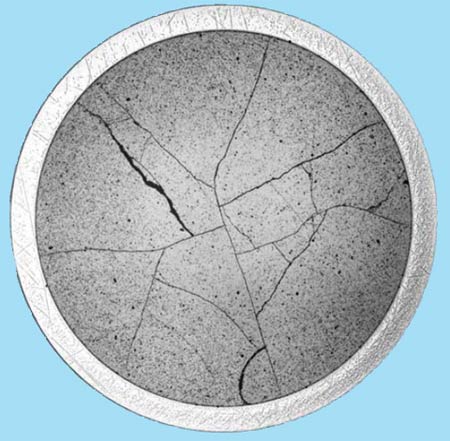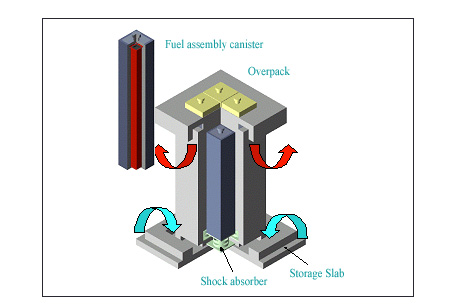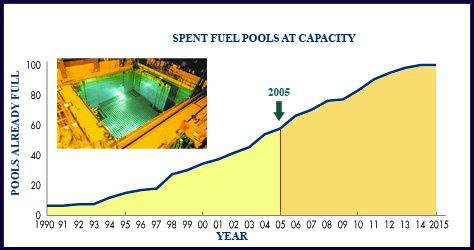Leave fuel as it is : do not reprocess
If the spent fuel does not undergo reprocessing, the fuel assemblies are left as they are. The uranium oxide pellets remain inside the cladding that kept them out of contact with the water in the reactors. This cladding is made of zirconium alloys. It continues to confine radioactivity effectively in the medium term in the pools and silos where the fuel assemblies are stored after removal from the reactor.

Spent fuel pellet
Irradiated fuel is an most highly complex physical-chemical material. Fission fragments belong to some forty chemical species. They lose fission energy as they collide with atoms in the material, displacing them by a few hundred microns. Fuel undergoes various transformations inside the reactor which leave it in a state of potential imbalance. This cross-section of an irradiated fuel pellet shows the cracking caused by fission, high temperatures and the difference in temperature between the core and the outer edge.
© Clés CEA
Fuel that has not been reprocessed contains plutonium, which makes it more radiotoxic than vitrified waste, which does not. After a hundred years, plutonium accounts for 84% of the radiotoxicity of spent fuel assemblies destined for deep geological disposal.
So far, the United States has chosen not to reprocess spent fuel. Radioactive waste is currently stored in pools near the power plants – the oldest waste has been stored in this way for decades.

Example of fuel assembly containers
Containers are necessary for long-term storage or disposal of spent fuel assemblies. They act as a first safety barrier, affording protection against external hazards and impacts during shipping, helping to remove heat and, above all, facilitating fuel handling. It is planned to place fuel assemblies inside canisters, in turn placed in overpacks, to ensure corrosion resistance and additional protection.
© CEA
But whether they are stored close to reactors or elsewhere, irradiated fuel assemblies cannot remain in storage pools or silos for ever. Some pools are already full. One day these assemblies will either have to be reprocessed or placed in a final disposal facility. As with vitrified waste, they must be perfectly sealed for thousands of years. Fuel assemblies are fragile. Before storage or disposal, they must be placed in canisters which form an additional safety barrier.
The Americans, who have long been leaders in the field, had plans to bury the accumulated civil and military waste under a mountain in the desert in Nevada. The Yucca Mountain project has now been abandoned, partly for political reasons.

Storage pool capacity in the USA
Forecast spent fuel storage capacity near American reactors. All 103 of the reactors currently in operation store their fuel in pools located nearby under licenses granted by the Nuclear Regulatory Commission (NRC). Some of the pools are already completely full and this should be the case for all of them by 2015. Some licensees also make use of dry storage facilities.
© DOE (source: Energy Resources International and DOE/RW-0431)
There are some drawbacks to direct geological disposal of spent fuel. The mass of spent fuel is 20 times greater than that of vitrified waste from reprocessing. It is far more radiotoxic as it contains plutonium, an element with very long-lived isotopes. It gives off more heat. For all these reasons, disposal facilities will be larger and costlier. Furthermore, if energy resources are in short supply, this waste will be coveted by future generations for its plutonium, a gram of which is equivalent to a tonne of oil. This would induce a risk of intrusion.
Some experts believe that burying uranium with irradiated fuel is a waste of precious resources. Conventional reactors only use 0.7% of the isotope 235 found in natural uranium, whereas, in terms of the theoretical energy potential that can still be tapped, a 500 kg spent fuel assembly is equivalent to around 10,000 tonnes of oil using slow reactors. This figure would increase to several hundred thousand tonnes of oil using fast breeder reactors which recycle their fuel. Assuming nuclear power is sustainable, the question is not so much “should we reprocess?” as “when and how should we reprocess?”.
Other articles on the subject « The waste issue »
Waste or resource?
Spent fuel can still generate a lot of energy The fuel removed from a reactor core after three or[...]
Fuel Reprocessing
The spent fuel reprocessing option Spent fuel reprocessing is derived from a process called the P[...]
What to do with plutonium
A highly strategic material and a hazardous type of waste What becomes of plutonium is central to[...]
Plutonium options
Plutonium: hazardous waste or miraculous raw material? For those who advocate pulling out of nucl[...]
Costs comparison
Reprocessing or not reprocessing: a comparison Which option for dealing with spent fuel from reac[...]